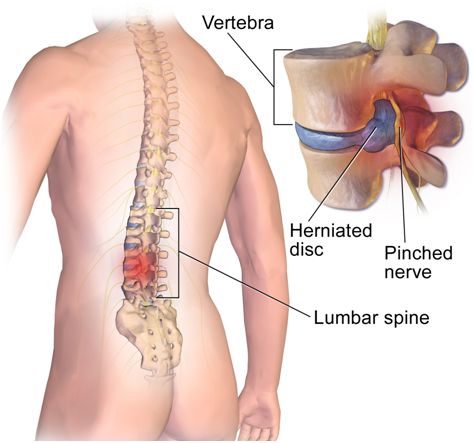Herniated Disc
A herniated disk refers to a problem with one of the rubbery cushions (disks) between the individual bones (vertebrae) that stack up to make your spine.
A spinal disk is a little like a jelly donut, with a softer center encased within a tougher exterior. Sometimes called a slipped disk or a ruptured disk, a herniated disk occurs when some of the softer “jelly” pushes out through a crack in the tougher exterior.

Symptoms
The symptoms come from pressure on and irritation of nerves.
It Usually Includes
- Pain that travels into one or both the legs
- Numbness or tingling in areas of one or both the legs
- Muscle weakness
- Loss of reflexes
Diagnosis
Diagnosis of a herniated disc begins with a complete history of the problem and physical examination.
Diagnostic tests such as MRI, CT scan, X ray, and EMG can be advised to confirm the diagnosis.
Treatment
There are several treatment modalities available, which depends on your symptoms.
Medication
Depending upon the severity of your pain, medications can be used to control it such as analgesics, opioids, cortisone injections, muscle relaxant.
Therapy
Physical therapists can show you positions and exercises designed to minimize the pain of a herniated disk. A physical therapist may also recommend:
- Heat or ice
- Traction
- Ultrasound
- Electrical stimulation
- Short-term bracing for the neck or lower back
Surgery
Your doctor may suggest surgery if conservative treatments fail to improve your symptoms after six weeks, especially if you continue to experience:
- Numbness or weakness
- Difficulty standing or walking
- Loss of bladder or bowel control
LLLT Treatment for Herniated Disc
LLLT is completely safe and has no effect on normal tissues. LLLT treats the underlying cause of the injury unlike pain medication which just masks the pain.
Inflammation is the body’s response to injury to attempt to heal it. But often the inflammatory reaction is excessive and this has a paradoxical inhibitory effect on the body’s natural healing mechanisms. This then perpetuates pain and dysfunction in the affected area.
By improving circulation and increasing cellular repair functions LLLT provides an environment for your body’s own natural healing processes to be activated and restored. Once normal immune processes are restored, the excessive inflammation is reduced and healing can begin.
You will be encouraged to move the affected area within range of movement/pain but not exert stretch or force during the healing phase.
The end result is resolution of inflammation and restoration of healthy tendons and local soft tissues. Once tissues are healed, pain is eliminated and normal range of motion and function is restored. Then muscle and tendon strength and flexibility can be addressed with graduated exercises and stretching.
LLLT has no known side effects, is safe and effective.

